The photostimulated quantum effect in rectangular quantum wire with an infinite potential for the case of electron-acoustic phonon scattering
Based on the quantum kinetic equation for electrons under the action of a linearly
polarized electromagnetic wave, a dc electric field and an intense laser field, analytic
expressions for the density of the direct current in rectangular quantum wire with an
infinite potential for the case of electron - acoustic phonon scattering are calculated. The
current density is studied as a function of the frequency of the laser radiation field, the
frequency of the linearly polarized electromagnetic wave, the temperature of system and
the size of quantum wire. The analytic expressions are numerically evaluated and plotted
for a specific quantum wire, GaAs/AlGaAs. All these results of quantum wire are compared
with bulk semiconductors and superlattices to show the differences.
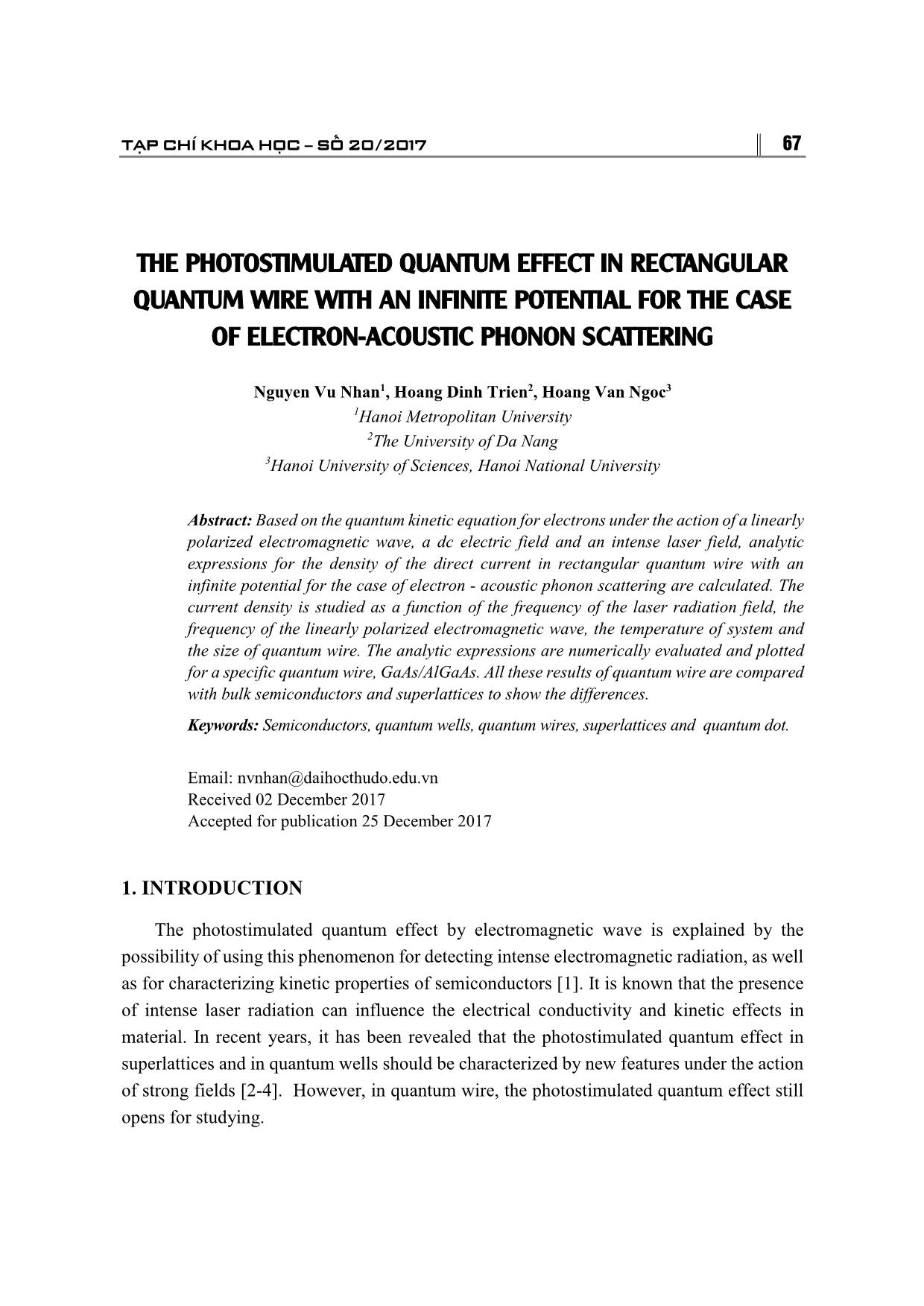
Trang 1
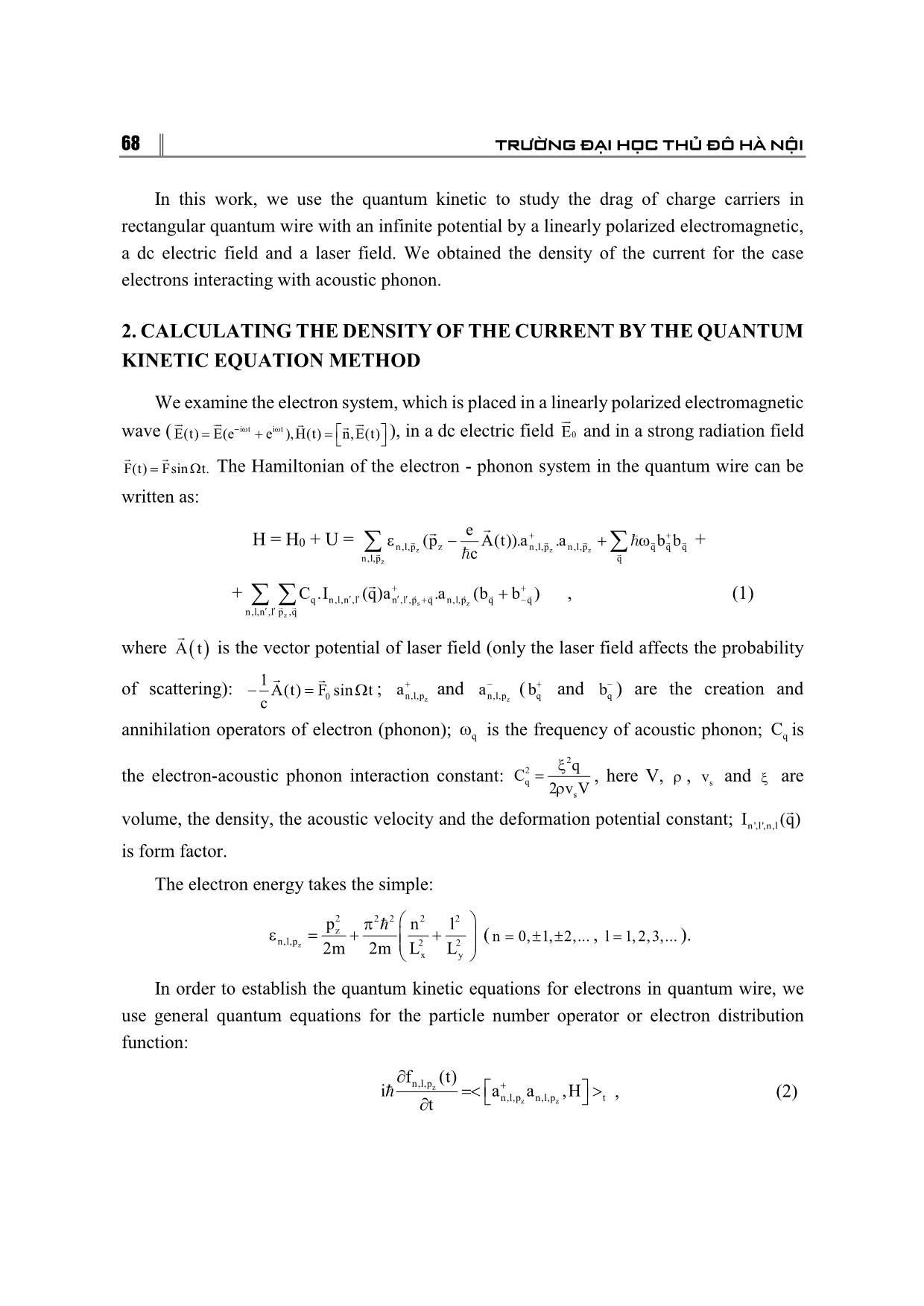
Trang 2
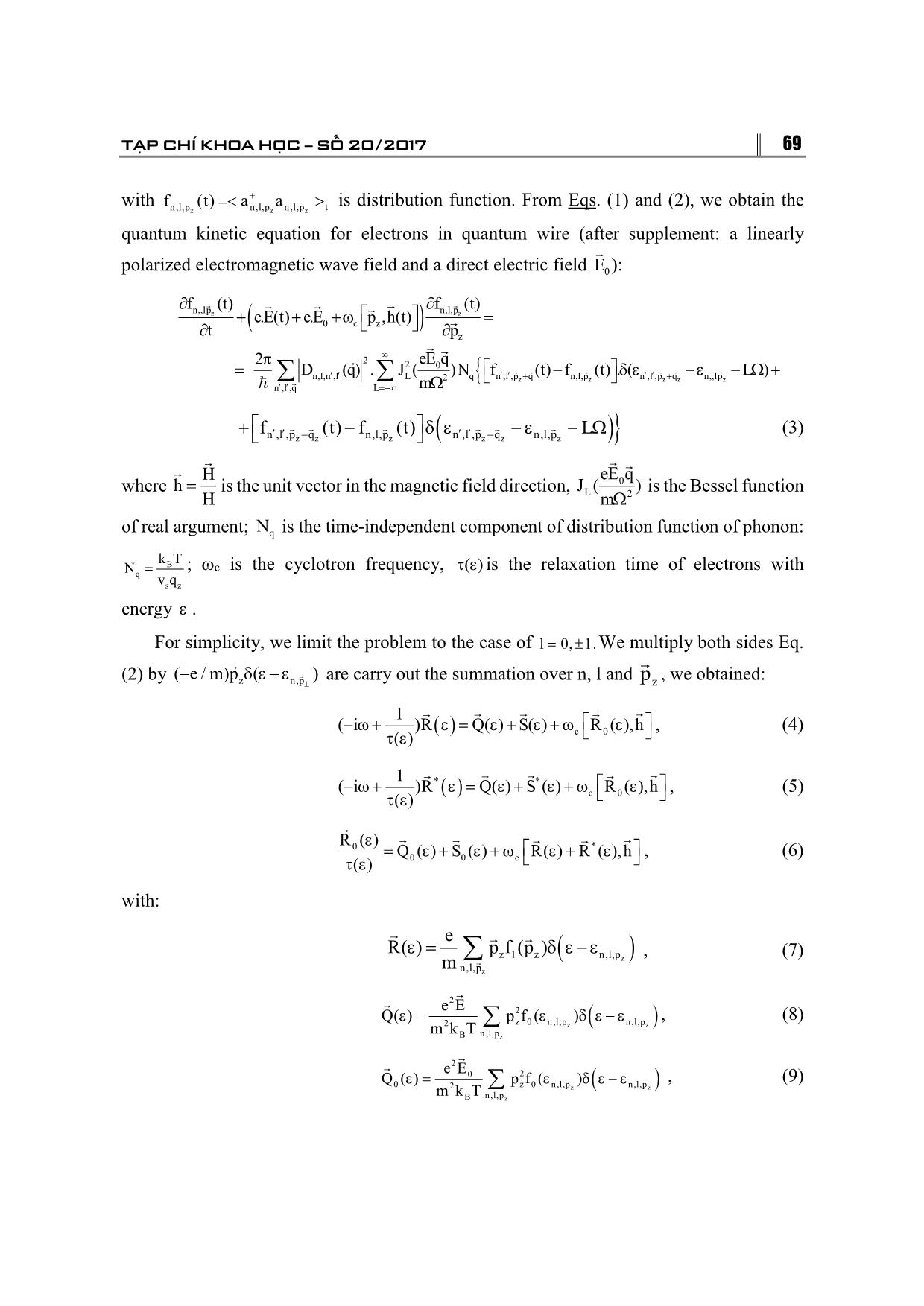
Trang 3
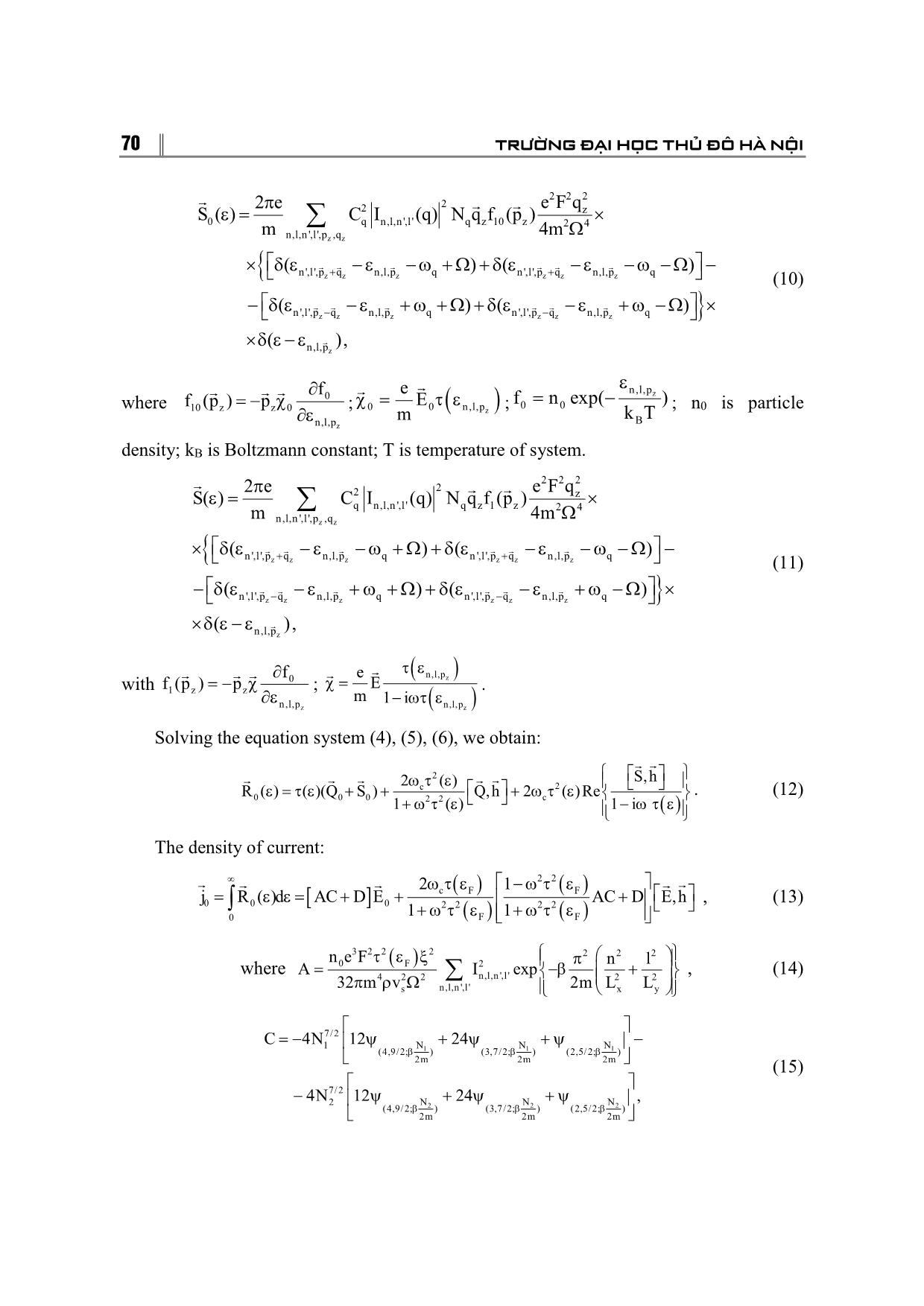
Trang 4
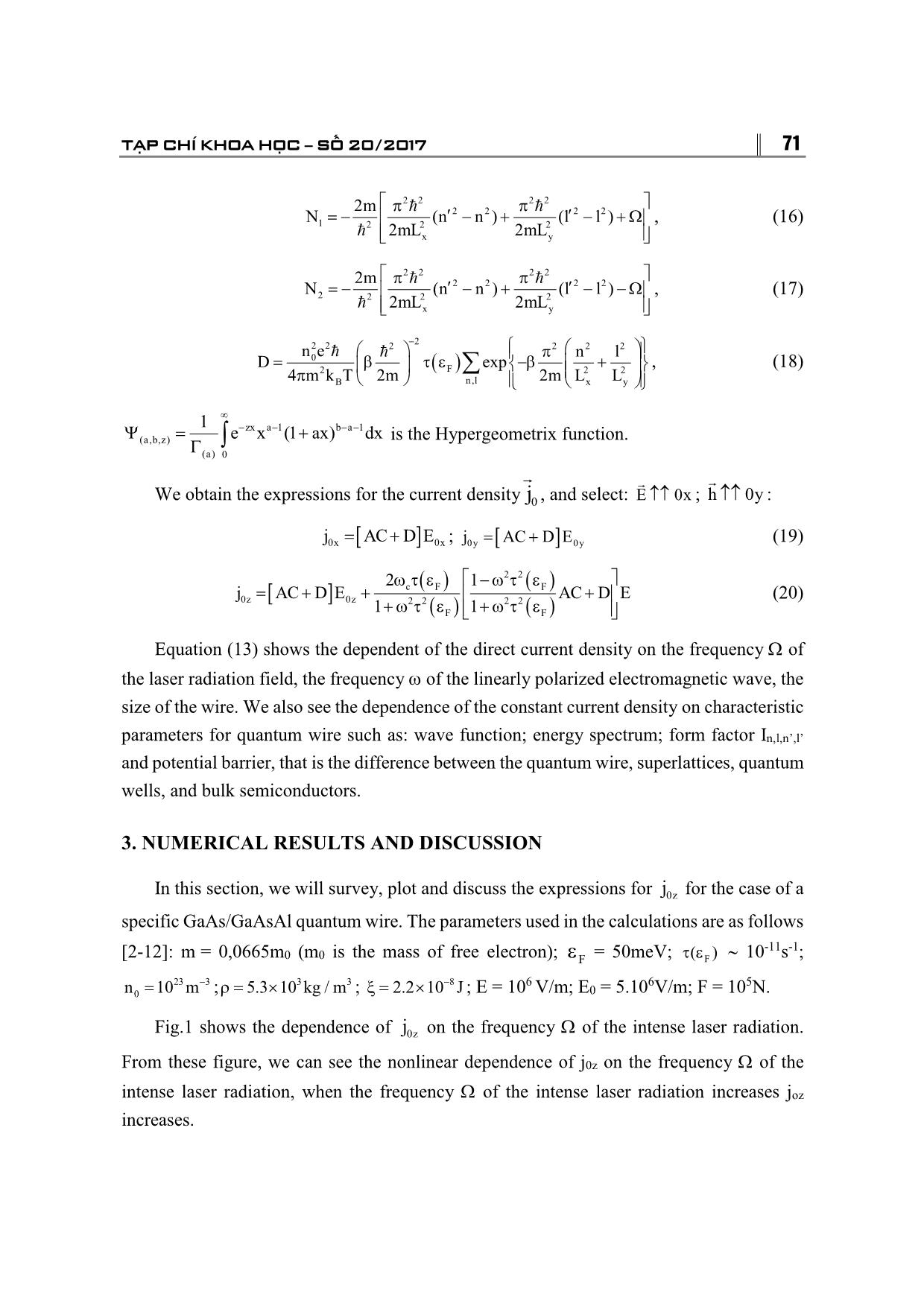
Trang 5
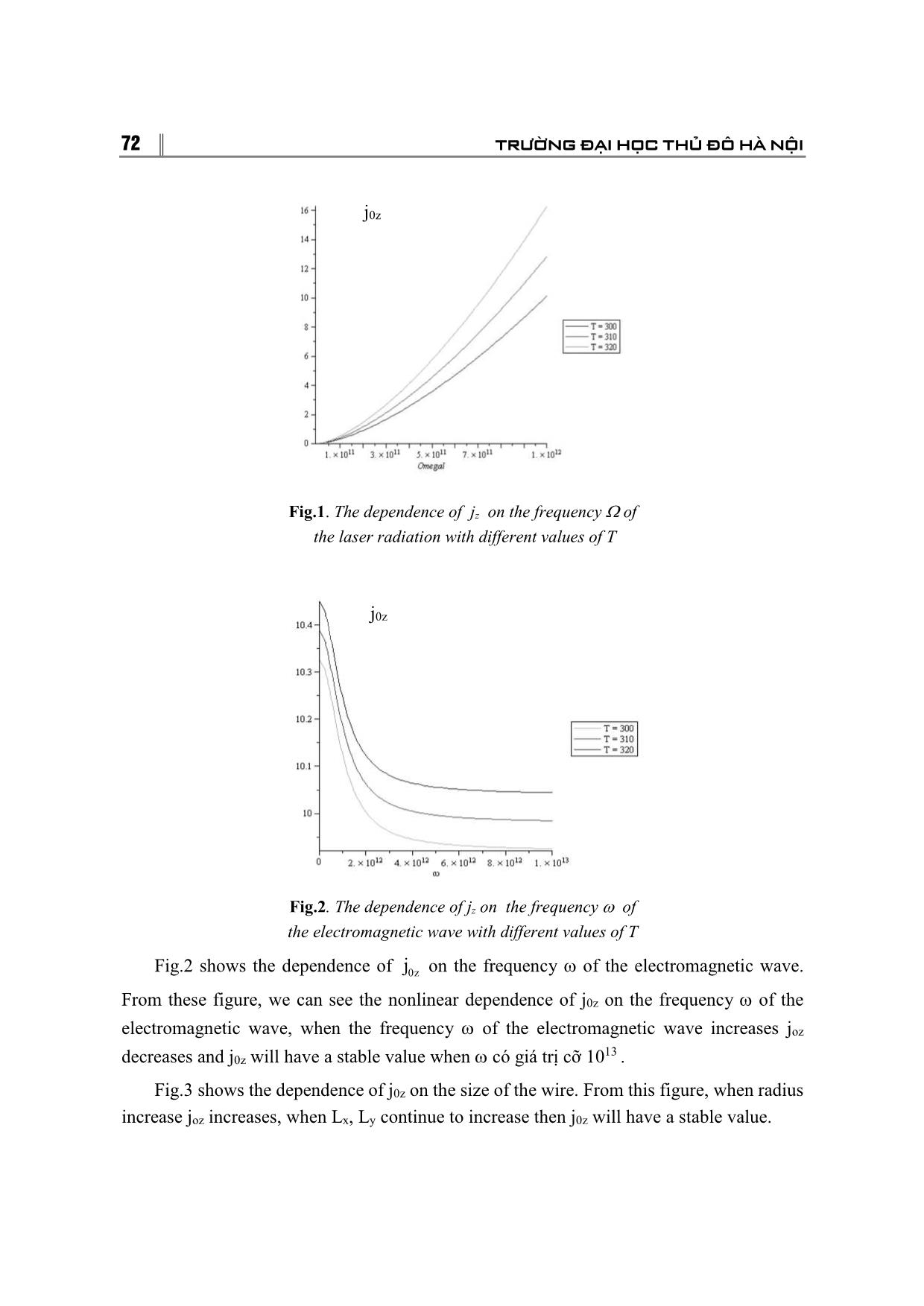
Trang 6
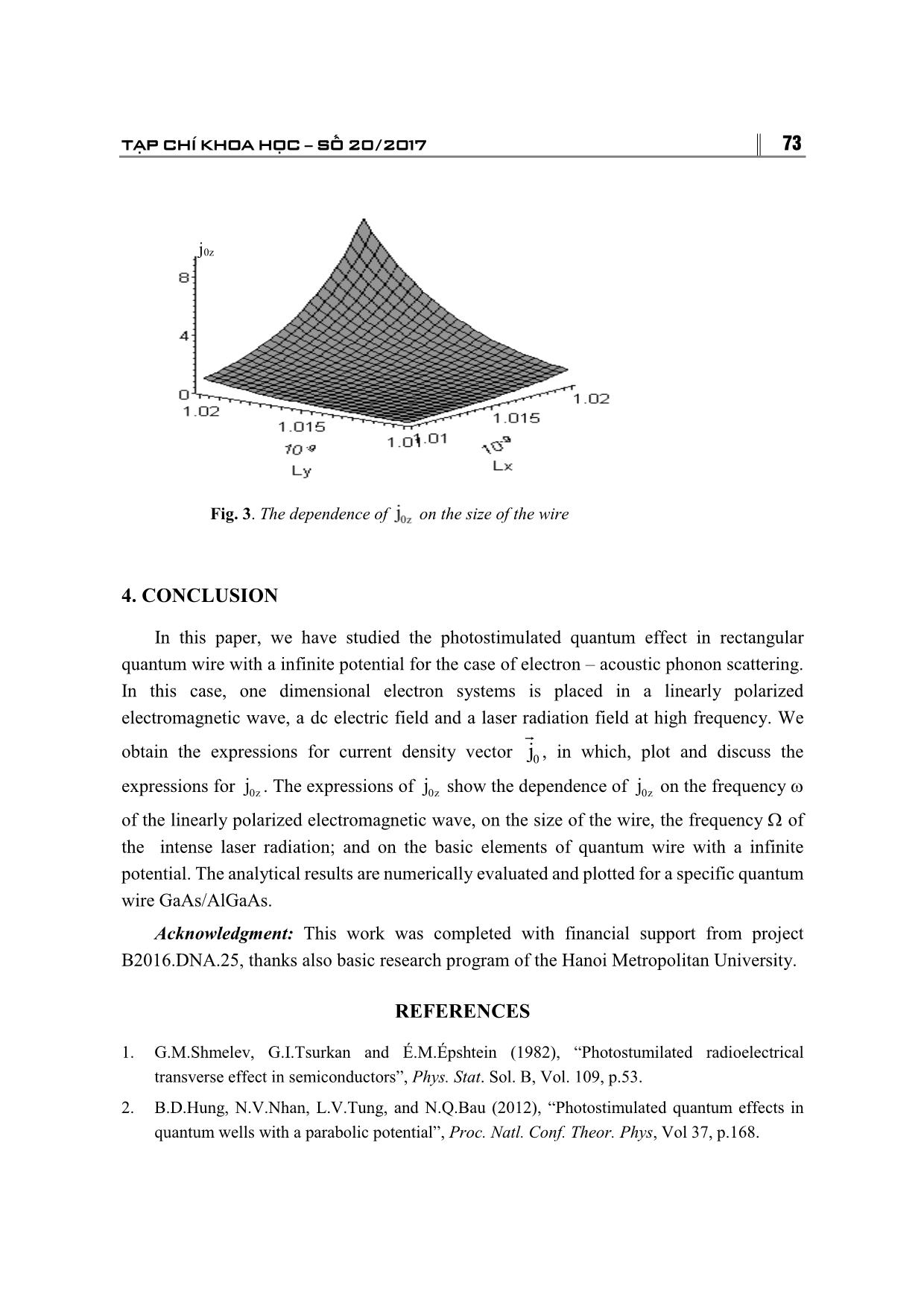
Trang 7
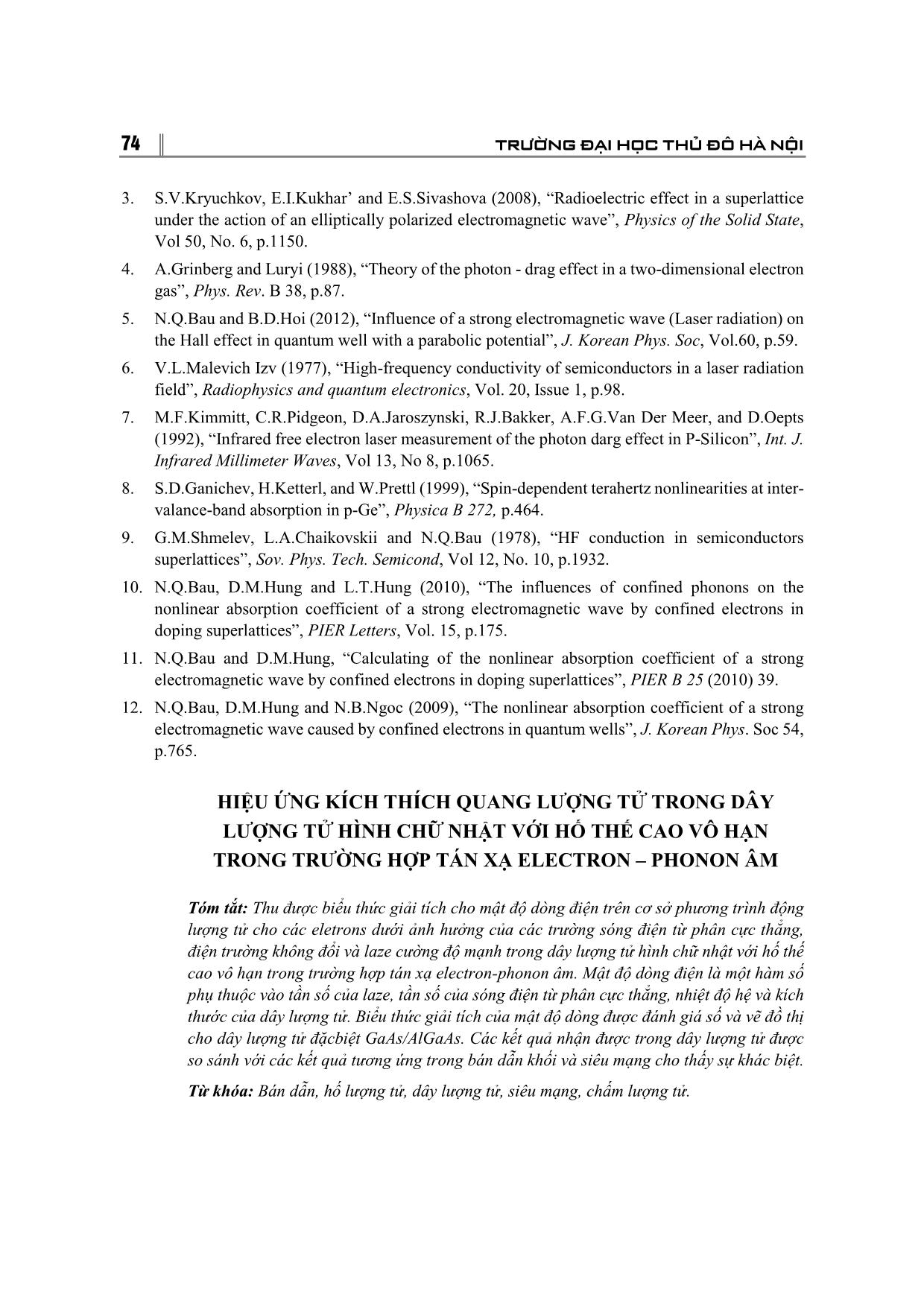
Trang 8
Tóm tắt nội dung tài liệu: The photostimulated quantum effect in rectangular quantum wire with an infinite potential for the case of electron-acoustic phonon scattering
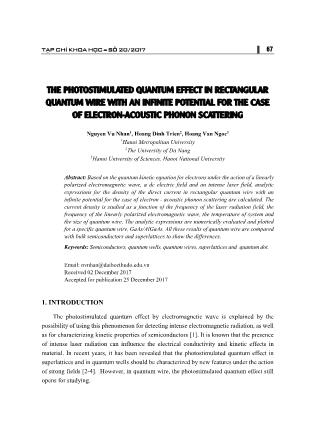
TẠP CHÍ KHOA HỌC SỐ 20/2017 67 THE PHOTOSTIMULATED QUANTUM EFFECT IN RECTANGULAR QUANTUM WIRE WITH AN INFINITE POTENTIAL FOR THE CASE OF ELECTRON-ACOUSTIC PHONON SCATTERING Nguyen Vu Nhan1, Hoang Dinh Trien2, Hoang Van Ngoc3 1Hanoi Metropolitan University 2The University of Da Nang 3Hanoi University of Sciences, Hanoi National University Abstract: Based on the quantum kinetic equation for electrons under the action of a linearly polarized electromagnetic wave, a dc electric field and an intense laser field, analytic expressions for the density of the direct current in rectangular quantum wire with an infinite potential for the case of electron - acoustic phonon scattering are calculated. The current density is studied as a function of the frequency of the laser radiation field, the frequency of the linearly polarized electromagnetic wave, the temperature of system and the size of quantum wire. The analytic expressions are numerically evaluated and plotted for a specific quantum wire, GaAs/AlGaAs. All these results of quantum wire are compared with bulk semiconductors and superlattices to show the differences. Keywords: Semiconductors, quantum wells, quantum wires, superlattices and quantum dot. Email: nvnhan@daihocthudo.edu.vn Received 02 December 2017 Accepted for publication 25 December 2017 1. INTRODUCTION The photostimulated quantum effect by electromagnetic wave is explained by the possibility of using this phenomenon for detecting intense electromagnetic radiation, as well as for characterizing kinetic properties of semiconductors [1]. It is known that the presence of intense laser radiation can influence the electrical conductivity and kinetic effects in material. In recent years, it has been revealed that the photostimulated quantum effect in superlattices and in quantum wells should be characterized by new features under the action of strong fields [2-4]. However, in quantum wire, the photostimulated quantum effect still opens for studying. 68 TRƯỜNG ĐẠI HỌC THỦ ĐÔ HÀ NỘI In this work, we use the quantum kinetic to study the drag of charge carriers in rectangular quantum wire with an infinite potential by a linearly polarized electromagnetic, a dc electric field and a laser field. We obtained the density of the current for the case electrons interacting with acoustic phonon. 2. CALCULATING THE DENSITY OF THE CURRENT BY THE QUANTUM KINETIC EQUATION METHOD We examine the electron system, which is placed in a linearly polarized electromagnetic wave ( i t i tE(t) E(e e ),H(t) n,E(t) ), in a dc electric field 0E and in a strong radiation field F(t) Fsin t. The Hamiltonian of the electron - phonon system in the quantum wire can be written as: H = H0 + U = z z z z n ,l,p z n ,l,p n ,l,p q q q n,l,p q e (p A(t)).a .a b b c + + s z z q n,l,n ,l n ,l ,p q n,l,p q q n,l,n ,l p ,q C .I (q)a .a (b b ) , (1) where A t is the vector potential of laser field (only the laser field affects the probability of scattering): 0 1 A(t) F sin t c ; zn,l,p a and zn,l,p a ( qb and qb ) are the creation and annihilation operators of electron (phonon); q is the frequency of acoustic phonon; qC is the electron-acoustic phonon interaction constant: 2 2 q s q C 2 v V , here V, , sv and are volume, the density, the acoustic velocity and the deformation potential constant; n ',l ',n,lI (q) is form factor. The electron energy takes the simple: z 2 2 2 2 2 z n,l,p 2 2 x y p n l 2m 2m L L ( n 0, 1, 2,... , l 1, 2,3,... ). In order to establish the quantum kinetic equations for electrons in quantum wire, we use general quantum equations for the particle number operator or electron distribution function: z z z n,l,p n,l,p n,l,p t f (t) i a a ,H t , (2) TẠP CHÍ KHOA HỌC SỐ 20/2017 69 with z z zn ,l,p n,l,p n ,l,p t f (t) a a is distribution function. From Eqs. (1) and (2), we obtain the quantum kinetic equation for electrons in quantum wire (after supplement: a linearly polarized electromagnetic wave field and a direct electric field 0E ): z z z z z z z n,,lp n,l,p 0 c z z 2 2 0 n,l,n ,l L q n ,l ,p q n,l,p n ,l ,p q n,,lp2 n ,l ,q L f (t) f (t) e.E(t) e.E p ,h(t) t p eE q2 D (q) . J ( )N f (t) f (t) . ( L ) m z z z z z zn ,l ,p q n,l,p n ,l ,p q n,l,pf (t) f (t) L (3) where H h H is the unit vector in the magnetic field direction, 0L 2 eE q J ( ) m is the Bessel function of real argument; qN is the time-independent component of distribution function of phonon: B q s z k T N v q ; c is the cyclotron frequency, ( ) is the relaxation time of electrons with energy . For simplicity, we limit the problem to the case of l 0, 1. We multiply both sides Eq. (2) by z n,p( e / m)p ( ) are carry out the summation over n, l and zp , we obtained: c 0 1 ( i )R Q( ) S( ) R ( ),h ( ) , (4) * * c 0 1 ( i )R Q( ) S ( ) R ( ),h ( ) , (5) *0 0 0 c R ( ) Q ( ) S ( ) R( ) R ( ),h ( ) , (6) with: z z z 1 z n,l,p n,l,p e R( ) p f (p ) m , (7) z z z 2 2 z 0 n,l,p n,l,p2 n,l,pB e E Q( ) p f ( ) m k T , (8) z z z 2 20 0 z 0 n ,l,p n ,l,p2 n ,l,pB e E Q ( ) p f ( ) m k T , (9) 70 TRƯỜNG ĐẠI HỌC THỦ ĐÔ HÀ NỘI z z z z z z z z z z z z z z 2 2 2 22 z 0 q n,l,n ',l ' q z 10 z 2 4 n,l,n ',l ',p ,q n ',l ',p q n,l,p q n ',l ',p q n,l,p q n ',l ',p q n,l,p q n ',l ',p q n,l,p q e F q2 e S ( ) C I (q) N q f (p ) m 4m ( ) ( ) ( ) ( zn,l,p ) ( ), (10) where z 0 10 z z 0 n,l,p f f (p ) p ; z0 0 n,l,p e E m ; zn ,l,p 0 0 B f n exp( ) k T ; n0 is particle density; kB is Boltzmann constant; T is temperature of system. z z z z z z z z z z z z z z 2 2 2 22 z q n,l,n ',l ' q z 1 z 2 4 n,l,n ',l ',p ,q n ',l ',p q n,l,p q n ',l ',p q n,l,p q n ',l ',p q n,l,p q n ',l ',p q n,l,p q e F q2 e S( ) C I (q) N q f (p ) m 4m ( ) ( ) ( ) ( zn,l,p ) ( ) , (11) with z 0 1 z z n,l,p f f (p ) p ; z z n,l,p n,l,p e E m 1 i . Solving the equation system (4), (5), (6), we obtain: 2 2c 0 0 0 c2 2 S,h2 ( ) R ( ) ( )(Q S ) Q,h 2 ( )Re 1 ( ) 1 i . (12) The density of current: 2 2 c F F 0 0 0 2 2 2 2 F F0 2 1 j R ( )d AC D E AC D E,h 1 1 , (13) where 3 2 2 2 2 2 20 F 2 n,l,n ',l '4 2 2 2 2 n,l,n ',l 's x y n e F n l A I exp 32 m v 2m L L , (14) 1 1 1 2 2 2 7/2 1 N N N (4,9/2; ) (3,7/2; ) (2,5/2; ) 2m 2m 2m 7/2 2 N N N (4,9/2; ) (3,7/2; ) (2,5/2; ) 2m 2m 2m C 4N 12 24 4N 12 24 , (15) TẠP CHÍ KHOA HỌC SỐ 20/2017 71 2 2 2 2 2 2 2 2 1 2 2 2 x y 2m N (n n ) (l l ) 2mL 2mL , (16) 2 2 2 2 2 2 2 2 2 2 2 2 x y 2m N (n n ) (l l ) 2mL 2mL , (17) 22 2 2 2 2 2 0 F2 2 2 n,lB x y n e n l D exp 4 m k T 2m 2m L L , (18) zx a 1 b a 1 (a,b,z) (a) 0 1 e x (1 ax) dx is the Hypergeometrix function. We obtain the expressions for the current density 0j , and select: E 0x ; h 0y : 0x 0xj AC D E ; 0y 0yj AC D E (19) 2 2 c F F 0z 0z 2 2 2 2 F F 2 1 j AC D E AC D E 1 1 (20) Equation (13) shows the dependent of the direct current density on the frequency of the laser radiation field, the frequency of the linearly polarized electromagnetic wave, the size of the wire. We also see the dependence of the constant current density on characteristic parameters for quantum wire such as: wave function; energy spectrum; form factor In,l,n’,l’ and potential barrier, that is the difference between the quantum wire, superlattices, quantum wells, and bulk semiconductors. 3. NUMERICAL RESULTS AND DISCUSSION In this section, we will survey, plot and discuss the expressions for 0zj for the case of a specific GaAs/GaAsAl quantum wire. The parameters used in the calculations are as follows [2-12]: m = 0,0665m0 (m0 is the mass of free electron); F = 50meV; F( ) 10 -11s-1; 23 3 0n 10 m ; 3 35.3 10 kg / m ; 82.2 10 J ; E = 106 V/m; E0 = 5.106V/m; F = 105N. Fig.1 shows the dependence of 0zj on the frequency of the intense laser radiation. From these figure, we can see the nonlinear dependence of j0z on the frequency of the intense laser radiation, when the frequency of the intense laser radiation increases joz increases. 72 TRƯỜNG ĐẠI HỌC THỦ ĐÔ HÀ NỘI Fig.1. The dependence of jz on the frequency of the laser radiation with different values of T Fig.2. The dependence of jz on the frequency of the electromagnetic wave with different values of T Fig.2 shows the dependence of 0zj on the frequency of the electromagnetic wave. From these figure, we can see the nonlinear dependence of j0z on the frequency of the electromagnetic wave, when the frequency of the electromagnetic wave increases joz decreases and j0z will have a stable value when có giá trị cỡ 1013 . Fig.3 shows the dependence of j0z on the size of the wire. From this figure, when radius increase joz increases, when Lx, Ly continue to increase then j0z will have a stable value. j0z j0z TẠP CHÍ KHOA HỌC SỐ 20/2017 73 4. CONCLUSION In this paper, we have studied the photostimulated quantum effect in rectangular quantum wire with a infinite potential for the case of electron – acoustic phonon scattering. In this case, one dimensional electron systems is placed in a linearly polarized electromagnetic wave, a dc electric field and a laser radiation field at high frequency. We obtain the expressions for current density vector 0j , in which, plot and discuss the expressions for 0zj . The expressions of 0zj show the dependence of 0zj on the frequency of the linearly polarized electromagnetic wave, on the size of the wire, the frequency of the intense laser radiation; and on the basic elements of quantum wire with a infinite potential. The analytical results are numerically evaluated and plotted for a specific quantum wire GaAs/AlGaAs. Acknowledgment: This work was completed with financial support from project B2016.DNA.25, thanks also basic research program of the Hanoi Metropolitan University. REFERENCES 1. G.M.Shmelev, G.I.Tsurkan and É.M.Épshtein (1982), “Photostumilated radioelectrical transverse effect in semiconductors”, Phys. Stat. Sol. B, Vol. 109, p.53. 2. B.D.Hung, N.V.Nhan, L.V.Tung, and N.Q.Bau (2012), “Photostimulated quantum effects in quantum wells with a parabolic potential”, Proc. Natl. Conf. Theor. Phys, Vol 37, p.168. Fig. 3. The dependence of on the size of the wire j0z 74 TRƯỜNG ĐẠI HỌC THỦ ĐÔ HÀ NỘI 3. S.V.Kryuchkov, E.I.Kukhar’ and E.S.Sivashova (2008), “Radioelectric effect in a superlattice under the action of an elliptically polarized electromagnetic wave”, Physics of the Solid State, Vol 50, No. 6, p.1150. 4. A.Grinberg and Luryi (1988), “Theory of the photon - drag effect in a two-dimensional electron gas”, Phys. Rev. B 38, p.87. 5. N.Q.Bau and B.D.Hoi (2012), “Influence of a strong electromagnetic wave (Laser radiation) on the Hall effect in quantum well with a parabolic potential”, J. Korean Phys. Soc, Vol.60, p.59. 6. V.L.Malevich Izv (1977), “High-frequency conductivity of semiconductors in a laser radiation field”, Radiophysics and quantum electronics, Vol. 20, Issue 1, p.98. 7. M.F.Kimmitt, C.R.Pidgeon, D.A.Jaroszynski, R.J.Bakker, A.F.G.Van Der Meer, and D.Oepts (1992), “Infrared free electron laser measurement of the photon darg effect in P-Silicon”, Int. J. Infrared Millimeter Waves, Vol 13, No 8, p.1065. 8. S.D.Ganichev, H.Ketterl, and W.Prettl (1999), “Spin-dependent terahertz nonlinearities at inter- valance-band absorption in p-Ge”, Physica B 272, p.464. 9. G.M.Shmelev, L.A.Chaikovskii and N.Q.Bau (1978), “HF conduction in semiconductors superlattices”, Sov. Phys. Tech. Semicond, Vol 12, No. 10, p.1932. 10. N.Q.Bau, D.M.Hung and L.T.Hung (2010), “The influences of confined phonons on the nonlinear absorption coefficient of a strong electromagnetic wave by confined electrons in doping superlattices”, PIER Letters, Vol. 15, p.175. 11. N.Q.Bau and D.M.Hung, “Calculating of the nonlinear absorption coefficient of a strong electromagnetic wave by confined electrons in doping superlattices”, PIER B 25 (2010) 39. 12. N.Q.Bau, D.M.Hung and N.B.Ngoc (2009), “The nonlinear absorption coefficient of a strong electromagnetic wave caused by confined electrons in quantum wells”, J. Korean Phys. Soc 54, p.765. HIỆU ỨNG KÍCH THÍCH QUANG LƯỢNG TỬ TRONG DÂY LƯỢNG TỬ HÌNH CHỮ NHẬT VỚI HỐ THẾ CAO VÔ HẠN TRONG TRƯỜNG HỢP TÁN XẠ ELECTRON – PHONON ÂM Tóm tắt: Thu được biểu thức giải tích cho mật độ dòng điện trên cơ sở phương trình động lượng tử cho các eletrons dưới ảnh hưởng của các trường sóng điện từ phân cực thẳng, điện trường không đổi và laze cường độ mạnh trong dây lượng tử hình chữ nhật với hố thế cao vô hạn trong trường hợp tán xạ electron-phonon âm. Mật độ dòng điện là một hàm số phụ thuộc vào tần số của laze, tần số của sóng điện từ phân cực thẳng, nhiệt độ hệ và kích thước của dây lượng tử. Biểu thức giải tích của mật độ dòng được đánh giá số và vẽ đồ thị cho dây lượng tử đặcbiệt GaAs/AlGaAs. Các kết quả nhận được trong dây lượng tử được so sánh với các kết quả tương ứng trong bán dẫn khối và siêu mạng cho thấy sự khác biệt. Từ khóa: Bán dẫn, hố lượng tử, dây lượng tử, siêu mạng, chấm lượng tử.
File đính kèm:
 the_photostimulated_quantum_effect_in_rectangular_quantum_wi.pdf
the_photostimulated_quantum_effect_in_rectangular_quantum_wi.pdf

